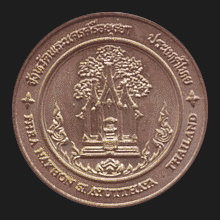|
Ayutthaya (อยุธยา)
Thai-Sanskrit name that derives from the word yuttha (ยุทธ), meaning ‘battle’, as in
yutthahadtie, i.e. hand-to-hand combat on the back of
war elephants, and translates ‘invincible’, ‘impregnable’, ‘unconquerable’, and ‘undefeatable’. It is the name of a Thai province, as well as its capital (map)
situated in Central Thailand
approximately 76 kilometers North of
Bangkok at the confluence of three rivers, the
Chao Phya, to the South and to the West of the city; the Pa Sak to its East (fig.); and the
Lopburi to its North. This contemporary city numbers around 60,000 inhabitants and its province has the same name. The place is named after
Ayodhaya and its official and full name is
Phra Nakhon Sri Ayutthaya. In history (fig.), it was a kingdom that flourished between 1350 and 1767, and is considered to be Thailand's second capital, after the decline of
Sukhothai. Until its destruction in 1767 the kingdom of Ayutthaya was ruled for 417 years by 34 kings (35 reigns) of 5 different dynasties and during its heydays it was a fortified city (map - fig.)
bigger than the city of London of that time. Prior to 1350, when the capital was moved from
U-Thong to its present location, it was an outpost of the former
Khmer empire. After its foundation in 1350, the city developed rapidly over the next few decades, to become a thriving centre of trade, as well as the military command centre of that time (fig.). Due to its perfect location, an island well protected by the confluence of three rivers and with the
Chao Phya River being a direct route linking it with the Gulf of Siam (now the
Gulf of Thailand), it attracted both large and small boats from important towns in the kingdom, as well as from other nations to engage in commerce. Due to this the city was filled with a great diversity of people from different areas and nationalities. Thus, foreign trade missions were established, including a Dutch mission of the
United East Indian Company
(fig.). It is also a Central Thai art style of the period between 1350 and 1767, divided into three distinct main periods: an early period from 1350 to 1488, an intermediate period from 1488 to 1630, and a declining period from 1630 to the destruction of the city in 1767. The style characteristics changed gradually from Khmer and revived Sukhothai influences to a more distinctive own Ayutthaya style, showing crowns and jewels on
Buddha images. In its declining period, the style is considered baroque. Both the city and the province have many historical sites and
places of interest. This province has 16
amphur, which are divided into 209
tambon and in 1,328 villages, called
mu ban.
There are plenty of historical sites and plces of interest all over the city and province, including the King
Naresuan Memorial (map - fig.). See also
Ayutthaya data file, WATCH VIDEO (1) and (2), and
MORE ON THIS.
回






|

